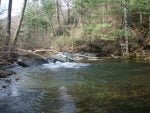Finding Untouched Water
Before anyone gets upset about this post’s content, remember that very few people will take the time to walk away from the easy water to get to a remote fishing location. According to WildtroutStreams.com, there are tens of thousands of miles of trout water in the Eastern US. A good discussion of locating new water will spread the pressure from the streams publicized in the various State Fish and Game sites and reduce the overall impact.
All the example spots below are well-known and well-marked on the VDGIF website.
Rule 1: Look for a waterfall

Waterfalls are usually not marked on the map as such unless water runs there year-round. The fact that this stream had two waterfalls (actually three, just two marked) indicated that it had promising water. Waterfalls also mean deep pools and great scenery. For more on this hike, go to Cedar Run
Rule 3: Look for long steep inclines

Steep inclines lead to pocket water. As water tumbles down a steep slope, it will pool in many places. The exact amount of water on a gentle slope typically will result in a very shallow creek. On a steep slope, it will collect in dips and hollows, creating a habitat that will support wild trout. This was Hogcamp Branch.
Rule 6: Look for a blue line with no trail

Once you start putting some of the above rules into operation, you want to find a place that is hard to get to so you can have a quiet fishing experience unbothered by hikers. The middle part of the Rose River is a great example of that. Note how it has a Falls, a tributary, a steep incline, and a hard hike away from the trail.
Rule 8: Visit odd non-fishing-related sites
Fishermen are not the only folks out there who are interested in water – hikers like to walk near water or look at water, swimmers like to dip in it, and kayakers like to blast through it. These interest groups have web sites and forums dedicated to sharing experiences. Look on these for discussions about water, streams, and rivers, and you may find some remote areas that are worth fishing. My experience from the Shenandoah is that few people carry a fishing rod when they head to the woods – otherwise, they would be on a fishing forum.
For example, go to American Whitewater and you will see the list of all the water in Virginia that is interesting to Kayakers
Need another one? How about the MidAtlantic Hikes or Hiking Upward sites? Sometimes, they rate streams!
One final example is swimming holes. You can click on the state and see places folks have registered – like this hole off Laurel Run up by the North Branch
So… how do you find new water? Chasin’ blue lines is one approach that will give you a workout when you hit the woods and may reveal a pot of gold at the end of the hike. Here are some guidelines I follow when hunting for new water
As you work through the rules with supporting maps and the related trip reports below, note that I could have used several of the same shots for multiple rules but chose to use different maps and locations so you could see a diversity of examples.
Of all the rules, finding waterfalls is the most obvious way to find good prospective water, followed closely by streams with multiple feeders that are a long, hard hike from the parking lot!
Rule 2: Avoid intermittent streams

This shot of Jeremy’s Run demonstrates why it is such a weak stream. Note that the two streams that form its headwater are intermittent (marked by the dots on the blue line). This indicates no year-round water source to keep this full and vibrant. Some spring seeps probably keep the trout alive, but when you hit the creek on the trail, you are instantly not impressed by what you see. For more on this hike, go to Jeremy’s Run
Rule 4: Look for multiple tributaries

This is the opposite of avoiding intermittent streams. You want to find a blue line fed by many other blue lines – all of which should (ideally) not start with the series of blue dots that indicate they are intermittent. A set of strong tributaries will contribute to the water volume and make the main line a great fishing experience. In addition, you may find that some of these are nice strong streams on their own right, and you can fish right up them. This was the upper Hughes River.
Rule 7: Look for the hard hike

The more brutal the hike, the fewer people and the bigger the fish. The most brutal hike I have ever taken is the Red Rocks trail into the Black Canyon. It’s a demanding 2000-foot vertical drop on a very narrow trail with some sporty sections. But, the fishing was fantastic at the other end .
Rule 9: Look for special regulations
Special regulations are a red flag that there is a section of water, national park, or other terrain that has enough resources to protect. For example, Shenandoah National Park has a single hook and no bait regulation throughout the park. This tells you that they do have wild trout and that they have been protected.
Rule 10: Use your GPS to keep from getting lost!
Now that you have found your water ensure you can return to the truck. Mark your truck as a waypoint before you leave, and you can always use the track back or navigate to the waypoint to find your way back.
Amazon.com Widgets
Unless stated otherwise, this article was authored by Steve Moore









































